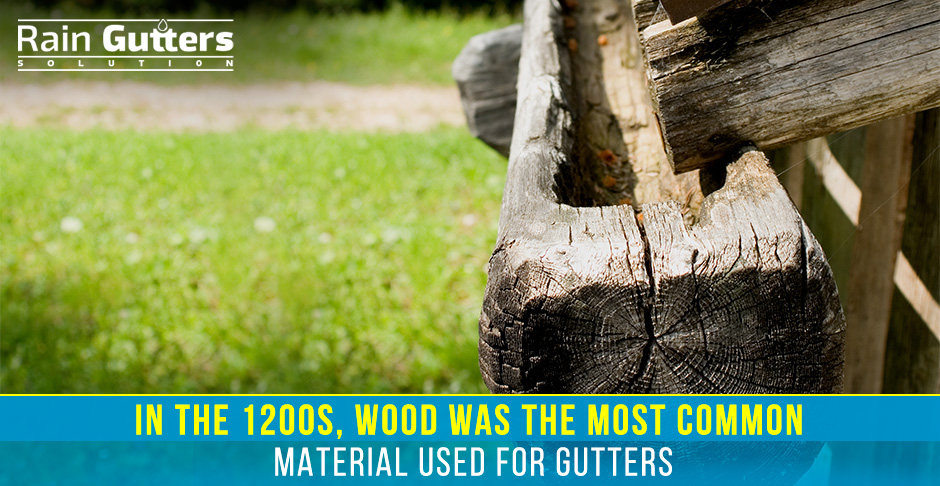Then and Now: The History of Rain Gutters
November 16, 2017

What do we really know about rain gutters? We know that they are a crucial part of every home and a necessary investment. Also, not having them can cause a lot of headaches in the future and force homeowners to spend a lot of money repairing water-related damage. Whether you have standard or
custom rain gutters, the most important part about having them it is that they are maintained in good working order. Water can pose a lot of dangers to your house, and the best way to avoid problems is to keep your gutters working properly.
Although there are many types of drainage systems currently on the market, gutters have a long history. In fact, people have been using them for thousands of years, but they have not always looked like the ones we know and love today. Here is a brief tour through the history of rain gutters:
The First Gutters
As early as 3,000 B.C., ancient civilizations started draining water using a system made of stone, brick, and wood. The main objective of these ancient gutters was to move water from one location to another. The Romans were the first to use drainage systems to drain water away from streets. Also, other ancient civilizations used water spouts perched on roofs to drain water to the ground. Amazing, isn't it?
Gargoyle Gutters
This system was used during the Middle Ages. Since many European monarchs were building large structures such as cathedrals and palaces, architects had water spouts in the form of gargoyles constructed to redirect rainwater away from buildings.
 1200s
1200s
During the 1200s, wood, lead, and clay became the most common materials used to make gutters, replacing the gargoyle gutters of the Middle Ages. The Tower of London, which was built around 1240, was the first known structure to have this type of gutter, and it was also the first to have downspouts. This method was used to protect the bridge's white walls, and the new drainage system became very popular in no time.
1500s – 1945s
In the 16th century, a lot of new designs were incorporated into gutter systems. One major change was that lead gutters started to be replaced by iron gutters, which quickly became the number one material used to make gutters because it was easy to find and inexpensive. In fact, in those days, houses were sold with built-in gutter systems that were designed to complement the architectural style of the buildings.
Although rain gutters made from rudimentary metals were being used by the 1700s, they were not mass-marketed until after the Industrial Revolution. Thanks to the technological advancements made during the early- to mid-20th century, gutters started being produced in a wide array of materials, such as copper, aluminum, galvanized steel, and plastic. All these materials are still used today.
1960s
In the 1960s, something extraordinary happened. A machine that could create aluminum gutters more quickly and cost-effectively was invented. At the time, this material was a very common choice for gutters, and the new machine could create roll-form, or seamless, gutters. Aluminum rain gutters are still very popular today.
Even though rain gutters have changed over time – including their building materials, design, and types – the main objective has not changed at all: Drain water away from buildings. Gutters play an important role in any drainage system and cannot be ignored if you want to maintain your home in good condition.
Currently, there are many options when it comes to rain gutters. In fact, you can even match them to the to the color and style of your roof or install rain chains, which are a type of custom rain gutter. Most people choose seamless gutters because they help ensure that your drainage system does not leak or overflow during the rainy season. Here are some of the options you have when selecting rain gutters:
 Material
Material- Aluminum
- Copper
- Galvanized steel
- Vinyl
Shape
Rain Chain Types
As you can see, you have plenty of options when selecting gutters for your home. However, once they are installed, you still need to check on them periodically to make sure they are good working order. Gutters also need regular maintenance for them to work properly. Doing this can help you avoid a lot of problems.
Here are some of the damages that your house can suffer if your gutters are malfunctioning:
- Garden erosion
- Damaged exterior
- Flooded basement or attic
- Roof damage
- Damage to siding
- Damage to the building's foundation
- Decreased property lifespan
Additionally, it is very important to keep in mind that if you decide to get new gutters, you should hire professionals to install them for you. If you are thinking about setting them up by yourself, something can easily go wrong, which could cause problems later on down the road. Besides, rain gutters are very cheap compared to the money you would have to spend if your house suffered some of the damages mentioned above.
If you want to prepare your house for the next rainy season and need to install rain gutters, we are your best option! Our experts have more than 20 years of experience installing rain gutters in Miami-Dade County. Get a free quote by filling out our
contact form or calling us at
(305) 270-7779. To find out about our latest promotions or learn more about our services, subscribe to our
newsletter and follow us on
Facebook at Rain Gutters Solution,
Twitter @RainGuttersSolution and
Instagram @GuttersSolution.

 1200s
1200s Material
Material